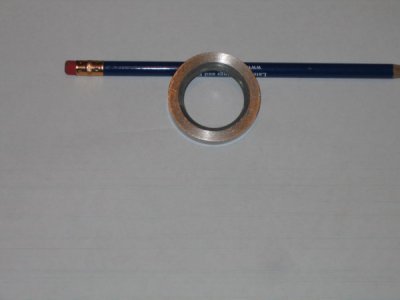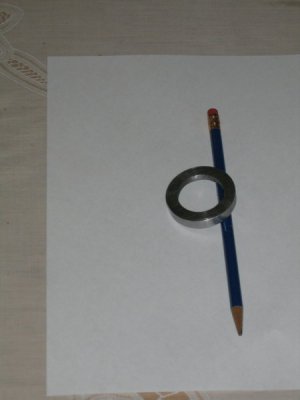- Joined
- Jul 2, 2014
- Messages
- 7,594
To get a good reading with a "TELESCOPING" gauge  , first have a set that have not been abused or left to get rusty and filthy. They will be hopeless. Cheap ones are usually frustrating. You want gages that lock with light pressure, and then the parts slide smoothly smoothly and evenly on each other. If you crank them down, it will gall and distort them, and then you can throw them in the trash, worthless. Whenever possible, get into a comfortable position where you can see clearly what you are doing. Collapse the gage so it will fit in the hole. Snug gently enough to hold against the spring pressure but not much more. Get the gage inside the hole, rotate the gage until it touches both walls gently, do not loosen the screw so the gage will "SNAP" into place. The gage must not be close to center, but on a definite angle to the bore so the setting is bigger than the bore. Then try to help get the gage in line with the bore, splitting it in half, no side loading or holding the handle off the bore center line. It really helps if you have good access and a good view of the bore, and a comfortable position. Success becomes easier. Then pull the lever down part way, trying to let the plungers find the exact center of the bore, and snug it just enough to keep it from slipping, and when measuring it with the micrometer.. The plungers want to find center, and will, if you do not add loading and motions off the bore center line. I ALWAYS (unless I can't avoid it) pull the handle smoothly DOWN, and smoothly swing the gage through the bore. If it does not feel perfect, do it over, until it is as good as you can get it. Then go to the micrometer. If the mic is set too small, when you rub the plungers over the anvil and spindle it will change the setting. Don't do that. Do the measuring with the lightest of touches on mic and TELESCOPING gage plungers. If you come against resistance, stop immediately, back off, open the mic a bit, and try again. I find it easiest to hold one plunger stationary on the fixed anvil of the mic., then swing the other plunger against the mic spindle. You want to make sure that you only get the perfect contact drag of the moving plunger in only one position on the spindle. You must work the plunger in two axes trying to find the smallest distance achievable with the plungers on the mic anvil and spindle. When you get that perfect drag in one spot, and ONLY in one spot, read the mic. Start over at the beginning and see if you get the same number. When you do, then take multiple readings of the same bore, until you consistently get the same number. You want to be getting the CORRECT number, the actual size of the bore, or all is in vain. So use a bore that is a known standard, in good condition. Multiple bore test gages of different sizes will help with real world measuring. Eventually, TELESCOPING gages will be a SNAP, but only if you take the time to learn to do it right. Someone good with TELESCOPING gages can measure bores within a tenth or two, day in and day out. That is probably better than most can do with fancy bore gages, which are quite expensive and mostly stand idle unless you do that sort of work all day, every day. Get a good set of
, first have a set that have not been abused or left to get rusty and filthy. They will be hopeless. Cheap ones are usually frustrating. You want gages that lock with light pressure, and then the parts slide smoothly smoothly and evenly on each other. If you crank them down, it will gall and distort them, and then you can throw them in the trash, worthless. Whenever possible, get into a comfortable position where you can see clearly what you are doing. Collapse the gage so it will fit in the hole. Snug gently enough to hold against the spring pressure but not much more. Get the gage inside the hole, rotate the gage until it touches both walls gently, do not loosen the screw so the gage will "SNAP" into place. The gage must not be close to center, but on a definite angle to the bore so the setting is bigger than the bore. Then try to help get the gage in line with the bore, splitting it in half, no side loading or holding the handle off the bore center line. It really helps if you have good access and a good view of the bore, and a comfortable position. Success becomes easier. Then pull the lever down part way, trying to let the plungers find the exact center of the bore, and snug it just enough to keep it from slipping, and when measuring it with the micrometer.. The plungers want to find center, and will, if you do not add loading and motions off the bore center line. I ALWAYS (unless I can't avoid it) pull the handle smoothly DOWN, and smoothly swing the gage through the bore. If it does not feel perfect, do it over, until it is as good as you can get it. Then go to the micrometer. If the mic is set too small, when you rub the plungers over the anvil and spindle it will change the setting. Don't do that. Do the measuring with the lightest of touches on mic and TELESCOPING gage plungers. If you come against resistance, stop immediately, back off, open the mic a bit, and try again. I find it easiest to hold one plunger stationary on the fixed anvil of the mic., then swing the other plunger against the mic spindle. You want to make sure that you only get the perfect contact drag of the moving plunger in only one position on the spindle. You must work the plunger in two axes trying to find the smallest distance achievable with the plungers on the mic anvil and spindle. When you get that perfect drag in one spot, and ONLY in one spot, read the mic. Start over at the beginning and see if you get the same number. When you do, then take multiple readings of the same bore, until you consistently get the same number. You want to be getting the CORRECT number, the actual size of the bore, or all is in vain. So use a bore that is a known standard, in good condition. Multiple bore test gages of different sizes will help with real world measuring. Eventually, TELESCOPING gages will be a SNAP, but only if you take the time to learn to do it right. Someone good with TELESCOPING gages can measure bores within a tenth or two, day in and day out. That is probably better than most can do with fancy bore gages, which are quite expensive and mostly stand idle unless you do that sort of work all day, every day. Get a good set of snap TELESCOPING gages and learn how to use them...
Warning: If you do not take the time to learn to do it right, you will have large errors and will turn much work into scrap...
Warning: If you do not take the time to learn to do it right, you will have large errors and will turn much work into scrap...


 lotsa good info
lotsa good info
